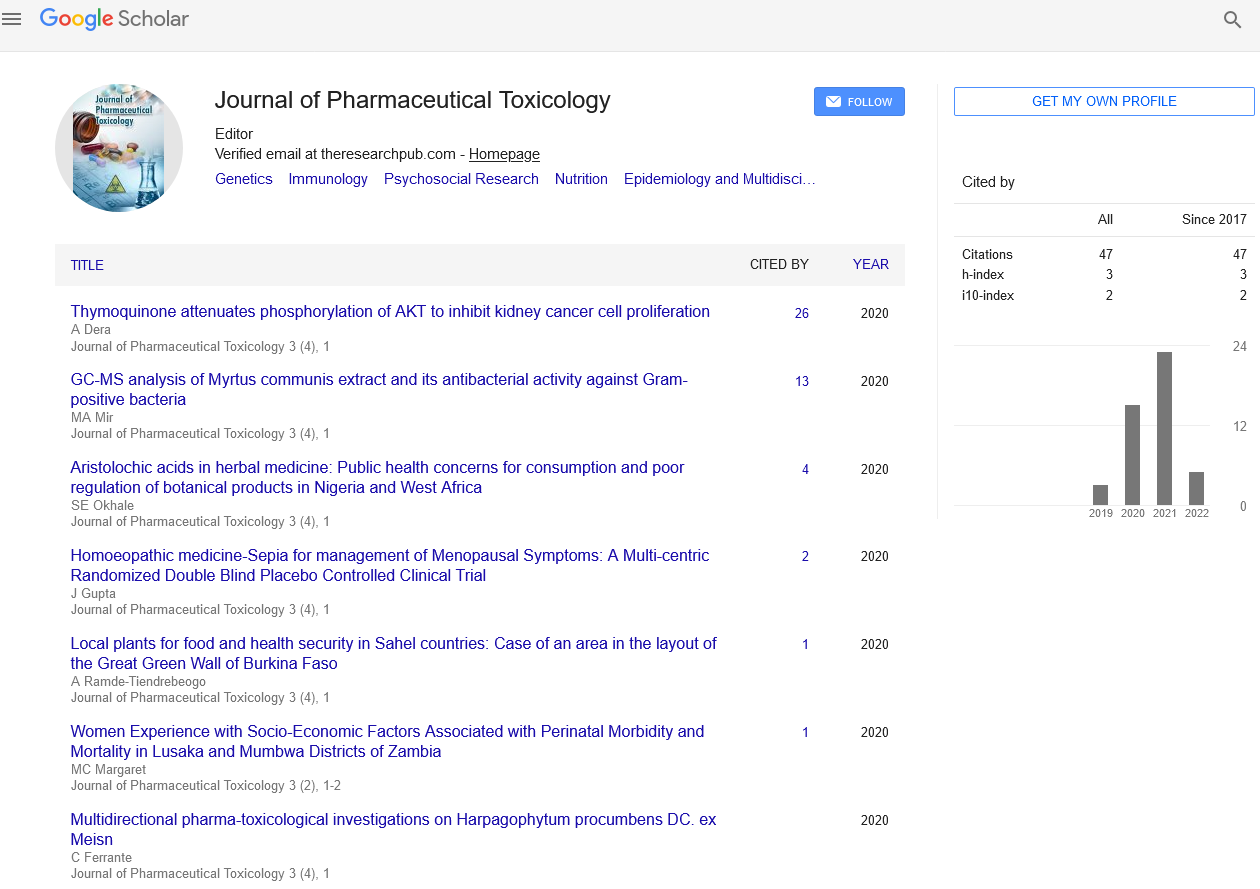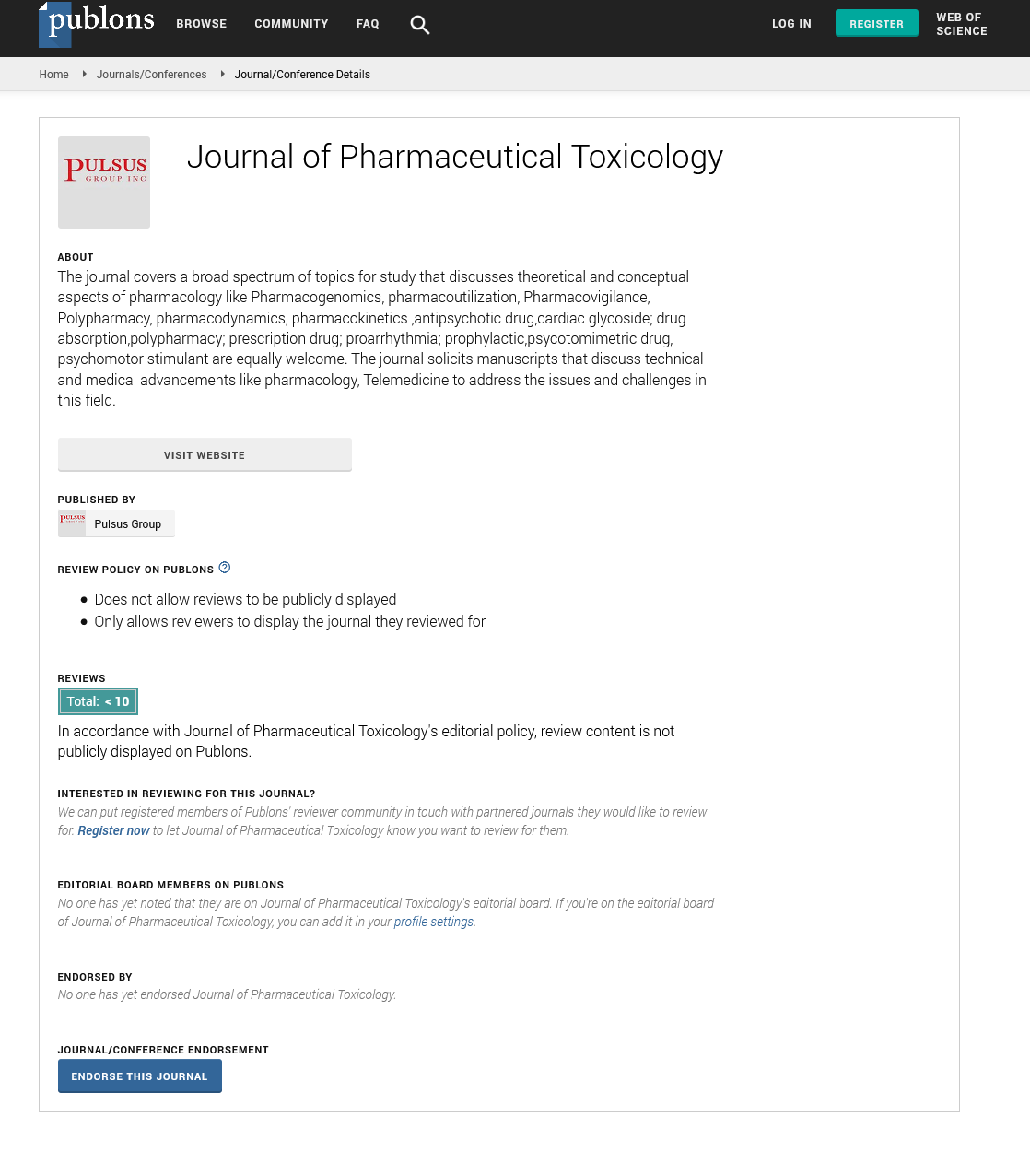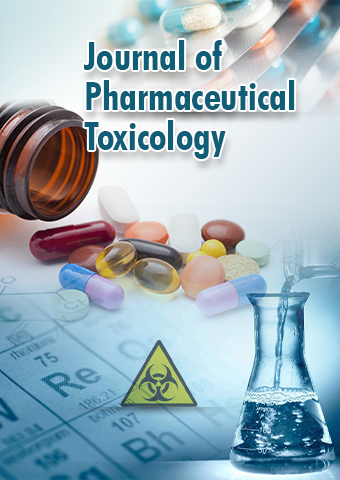Mini Review - Journal of Pharmaceutical Toxicology (2023) Volume 6, Issue 2
The Role of Pharmacokinetics in Pharmaceutical Toxicology
Yousif Asiri*
Department of Pharmacy, King Saud University, Saudi Arabia
Department of Pharmacy, King Saud University, Saudi Arabia
E-mail: Yousif.Asiri@gmail.com
Received: 03-April-2023, Manuscript No. jpt-23-96221; Editor assigned: 06-April-2023, PreQC No. jpt-23- 96221 (PQ); Reviewed: 20-April-2023, QC No. jpt-23-96221; Revised: 21-April-2023, Manuscript No. jpt-23- 96221 (R); Published: 28-April-2023 DOI: 10.37532/jpt.2023.6(2).54-56
Abstract
Pharmacokinetics (PK) is a branch of pharmacology that deals with the study of the absorption, distribution, metabolism, and elimination (ADME) of drugs in the body. PK plays a crucial role in pharmaceutical toxicology, which is the study of the harmful effects of drugs on living organisms. Pharmacokinetics helps to understand how drugs are absorbed, distributed, metabolized, and eliminated in the body. This knowledge is essential in predicting the potential toxicity of drugs, determining their therapeutic dose, and assessing the risk of adverse effects. By studying the PK of a drug, toxicologists can identify the critical factors that affect its toxicity, such as the route of administration, the duration of exposure, and the metabolism and elimination of the drug. One of the significant applications of PK in pharmaceutical toxicology is in the development of new drugs. PK studies are conducted during the preclinical phase of drug development to determine the optimal dosing regimen, evaluate the safety profile of the drug, and identify any potential adverse effects. The results of these studies are used to determine the starting dose for clinical trials and to guide the design of these trials.
Keywords
Interactions • Pharmaceutical toxicology • Intravenous administration
Introduction
PK is also essential in understanding drug interactions, which can affect the toxicity of drugs. Drugs can interact with each other by altering their PK properties or by acting on the same target or pathway in the body. For example, drugs that inhibit or induce drug-metabolizing enzymes can alter the PK of other drugs, leading to toxicity or reduced efficacy. Another important application of PK in pharmaceutical toxicology is in the evaluation of drug toxicity in different populations. PK studies can help to identify differences in the ADME of drugs in different age groups, genders, and ethnicities, which can affect the risk of adverse effects.
In conclusion, PK plays a crucial role in pharmaceutical toxicology by providing a framework for understanding the ADME of drugs in the body. By studying the PK of drugs, toxicologists can identify critical factors that affect their toxicity, predict their potential adverse effects, and evaluate their safety profile in different populations. PK is an essential tool in drug development, drug safety evaluation, and the prevention of drug-induced toxicity. Pharmacokinetics is a crucial aspect of pharmaceutical toxicology, as it determines the way in which drugs and other xenobiotic are absorbed, distributed, metabolized, and excreted by the body. Understanding these processes is essential for predicting and managing toxicological effects of drugs and other chemicals [1,2].
Pharmacokinetics can influence the toxicity of a substance in several ways. For example, the rate and extent of absorption can determine the dose that reaches the target organ or tissue, while distribution can determine which organs or tissues are affected by the drug or chemical. Metabolism can activate or deactivate the substance, while excretion can remove it from the body, reducing its toxic effects [3].
Pharmacokinetic parameters such as the half-life, clearance, and volume of distribution can be used to predict drug concentrations in different organs and tissues and to estimate the potential for toxicity. Toxicological studies often use pharmacokinetic data to establish safe exposure limits and to develop strategies for minimizing toxicity. In addition to influencing toxicity, pharmacokinetics can also be affected by toxicity. For example, some drugs and chemicals can inhibit or induce drug-metabolizing enzymes, leading to altered pharmacokinetics and potential toxicity. Similarly, toxic effects on organs such as the liver and kidneys can impair drug metabolism and excretion, leading to increased drug exposure and toxicity [4].
Discussion
Pharmacokinetics plays a critical role in the development and regulation of pharmaceuticals and other chemicals. Understanding the pharmacokinetics of these substances is essential for predicting their toxicological effects, establishing safe exposure limits, and developing effective strategies for minimizing toxicity. As such, pharmacokinetics is a fundamental aspect of pharmaceutical toxicology. Pharmacokinetics plays a crucial role in understanding the toxicological effects of pharmaceuticals. It refers to the study of how a drug is absorbed, distributed, metabolized, and eliminated from the body, which affects its toxicity.
In the case of pharmaceuticals, the toxic effects can occur due to various reasons, such as overdose, prolonged use, and interactions with other drugs. The pharmacokinetic properties of a drug determine its toxicity by influencing the concentration of the drug in the body and the duration of its exposure to various organs and tissues. The absorption of a drug determines the rate at which it enters the bloodstream and the extent to which it is available for distribution to various organs. A drug that is absorbed slowly may have a delayed onset of toxicity, while a drug that is absorbed rapidly may cause a sudden onset of toxicity [6,7].
The distribution of a drug depends on its solubility, protein binding, and lipid solubility. A drug that is highly soluble in fat may accumulate in adipose tissue and cause toxicity over a prolonged period. Similarly, a drug that is highly protein-bound may not be available for distribution to its target organ; leading to toxicity in other tissues. The metabolism of a drug involves its conversion to inactive or less toxic metabolites. However, some drugs may be metabolized to toxic metabolites that can cause organ damage. The rate of metabolism of a drug depends on various factors such as genetics, age, and other drugs that the patient may be taking.
The elimination of a drug from the body occurs through various routes such as renal excretion, biliary excretion, and metabolism. The rate of elimination of a drug determines its duration of exposure to various organs and tissues, which can affect its toxicity. In conclusion, pharmacokinetics plays a crucial role in understanding the toxicological effects of pharmaceuticals. The pharmacokinetic properties of a drug determine its toxicity by influencing its concentration and duration of exposure to various organs and tissues. Therefore, a better understanding of pharmacokinetics is essential for the development of safe and effective drugs. Pharmacokinetics (PK) is a crucial aspect of pharmaceutical toxicology as it determines the absorption, distribution, metabolism, and excretion of drugs and their metabolites in the body. These factors have a significant impact on the toxicity of drugs and their potential adverse effects. Understanding the PK parameters of drugs can help predict their toxicological profiles and enable the development of safe and effective therapeutic strategies [8].
Absorption is the process by which drugs enter the body, and it can occur through various routes such as oral, inhalation, topical, and intravenous administration. The rate and extent of drug absorption can be influenced by factors such as drug formulation, pH, and the presence of food or other drugs. For example, some drugs are more efficiently absorbed in an acidic environment, while others are better absorbed in a basic environment. Distribution refers to the spread of drugs throughout the body, and it is determined by several factors, including the drug’s physicochemical properties, protein binding, and tissue perfusion. Some drugs have a high affinity for specific tissues or organs, leading to their accumulation in those areas, which may result in toxic effects. Additionally, some drugs may displace other drugs from their binding sites, leading to altered distribution and potential toxicity.
Metabolism is the process by which drugs are broken down in the body, primarily by enzymes in the liver. Metabolism can result in the formation of active or toxic metabolites, and the rate of metabolism can be influenced by genetic factors, age, and drug-drug interactions. Some drugs can also induce or inhibit metabolic enzymes, leading to altered drug metabolism and potential toxicity. Excretion is the elimination of drugs and their metabolites from the body, primarily through the kidneys and liver. The rate of excretion can be influenced by several factors, including renal and hepatic function, pH, and drug-drug interactions. Drugs that are eliminated slowly may accumulate in the body, leading to toxic effects [9,10].
Conclusion
Pharmacokinetic modeling is an essential tool in pharmaceutical toxicology as it allows for the prediction of drug concentrations in various tissues and organs, which can be used to estimate toxicological effects. Additionally, pharmacokinetic modeling can be used to optimize drug dosing and minimize potential adverse effects.In conclusion, pharmacokinetics plays a vital role in pharmaceutical toxicology as it determines the fate of drugs in the body and their potential toxicological effects. Understanding the PK parameters of drugs can help predict their toxicological profiles and enable the development of safe and effective therapeutic strategies.
Conflict of Interest
None
Acknowledgement
None
References
- Khan DR. The use of nanocarriers for drug delivery in cancer therapy. J Cancer Ther. 2, 58-62 (2010).
- Wang X, Yang L, Chen Z et al. Application of nanotechnology in cancer therapy and imaging. CA Cancer J Clin. 58, 97-110 (2008).
- Gabizon AA. Pegylated liposomal doxorubicin metamorphosis of an old drug into a new form of chemotherapy. Clin Cancer Investig J. 19, 424-436 (2001).
- Roby A, Erdogan S, Torchilin VP et al. Enhanced in vivo antitumor efficacy of poorly soluble PDT agent, meso-tetraphenylporphine, in PEG-PE-based tumor-targeted immunomicelles. Cancer Biol Ther. 6, 1136-1142 (2007).
- Chen Q, Tong S, Dewhirst MW et al. Targeting tumor micro vessels using doxorubicin encapsulated in a novel thermo sensitive liposome. Mol Cancer Ther. 3, 1311-1317 (2004).
- Kersten GFA, Crommelin DJA. Liposomes and ISCOMs. Vaccine. 21: 915-920 (2003).
- Needham D, Dewhirst MD. The development and testing of a new temperature-sensitive drug delivery system for the treatment of solid tumors. Adv Drug Deliv Rev. 53, 285-305 (2001).
- Bentzen SM, Agrawal RK, Barrett JM et al. The UK standardisation of breast radiotherapy (START) trial a of radiotherapy hypo fractionation for treatment of early breast cancer a randomised trial. Lancet Oncol. 9, 331-341 (2008).
- Veronesi U, Orecchia R, Maisonneuve P et al. Intraoperative radiotherapy versus external radiotherapy for early breast cancer (ELIOT) a randomized controlled equivalence trial. Lancet Oncol. 14, 1269-1277.
- Albain KS, Barlow WE, Shak S et al. Prognostic and predictive value of the 21-gene recurrence score assay in postmenopausal women with node-positive, oestrogen-receptor-positive breast cancer on chemotherapy. Lancet Oncol. 11, 55-65 (2011)
Google Scholar, Crossref, Indexed at
Google Scholar, Crossref, Indexed at
Google Scholar, Crossref, Indexed at
Google Scholar, Crossref, Indexed at
Google Scholar, Crossref, Indexed at
Google Scholar, Crossref, Indexed at
Google Scholar, Crossref, Indexed at
Google Scholar, Crossref, Indexed at


